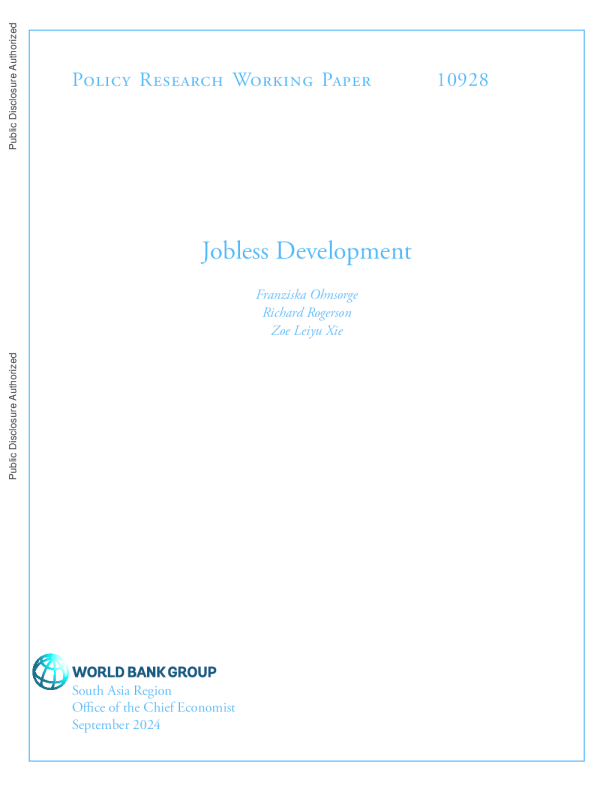失业发展
 AI智能总结
AI智能总结
10928 弗朗茨iska Ohnsorge理查德·罗杰森谢蕾雨曦 政策研究工作论文 10928 摘要 对各国人均GDP差异的分析几乎完全集中在生产率差异上。本文表明,在就业人口比率的短期动态变化方面也存在巨大差异。本文发现,对于大量新兴市场和发展中国家(EMDEs),生产率增长与就业人口比率的变化呈负相关,这一现象在本文中使用“无就业增长”这一术语进行描述。本文还表明,各国在就业人口比率稳态水平方面存在巨大差异,这些比率是各国正在趋同的。还有一些国家经历了其就业人口比率的显著增加。 在发展过程中的就业-人口比。本文采用两阶段程序,在对新兴市场和发展中国家的较大样本进行研究时探讨这一问题。在第一阶段,本文估计各国在就业比稳定状态上的差异。在第二阶段,本文记录了哪些制度和政策因素与就业比稳定状态相关联。研究发现,各国在女性就业比稳定状态上存在特别大的差异。女性权利的法律保护较少与女性较低的就业比稳定状态相关,而且没有对男性产生抵消的正向影响。 本文是南亚地区首席经济学家办公室的成果。它是世界银行更大规模努力的一部分,旨在提供其研究资料的自由获取,并为全球的发展政策讨论做出贡献。政策研究工作论文也发布在http://www.worldbank.org/prwp上。作者可以通过lxie@worldbank.org联系。 失业发展* , 以及 谢蕾玉弗朗茨iska Ohnsorge一个a,b理查德·罗杰森d c,一个世界银行,美国华盛顿特区bCEPR, 伦敦,英国;CAMA,堪培拉,澳大利亚c普林斯顿大学公共与国际事务学院d国家经济研究局 JEL-codes:J11; J16; J21; F66; O41; O47关键词:就业;新兴和发展中国家;结构性转型;女性劳动力参与率。 1. 引言 人均GDP的变化是追踪一个国家整体发展的最常用指标。因为人均GDP是工人人均GDP和就业人口比率的乘积,所以人均GDP的变化反映了生产率和就业人口比率的变动。特别是,在中等期限内,就业人口比率的变动可以减弱或放大生产率增长的影响。 我们提出了该术语无就业发展描述在生产力增长期间其就业人口比下降的国家。尽管大量文献研究了新兴市场和发展中经济体(EMDEs)的生产力增长动态,但这些国家的就业人口比动态却很少受到关注。在本文中,我们通过研究1990年以后的EMDEs就业人口比动态,来填补这一文献中的空白。1 一个导致在宏观经济背景下缺乏对劳动力市场成果关注的原因是,就业与人口比例在许多国家的横截面中与发展水平在很大程度上不相关。这导致研究人员在考虑其为重要因素时有所抽象。但这几乎为零的相关性并不意味着劳动力市场成果的差异很小;相反,在许多情况下,这些差异是很大的,我们的分析集中在这些差异上。 韩国和印度的例子旨在激励我们的分析。韩国和印度都经历了以人均GDP增长为衡量标准的长时期快速增长。在韩国,这一时期为1965-1987年,人均GDP增长了170个对数点。在印度,这一时期为1990-2018年,人均GDP增长了130个对数点。在这两个国家,人均GDP的快速增长时期也是生产率快速增长的时期——两国的人均GDP增长了140个对数点。 然而,韩国和印度的发展在一点重要方面存在差异。图1显示了自1960年以来韩国和印度就业人数与劳动年龄人口(以下简称EWAP)的对数比率的时序图。韩国的快速增长期与EWAP的大幅增加相吻合,而印度的快速增长期则与EWAP的大幅减少相关联。这种差异在数量上是重要的:1960年,印度EWAP比韩国高24个对数点,但到2019年,它比韩国低28个对数点——逆转了52个对数点。如果将2%视为“正常”的每人实际国内生产总值年增长的标准化值,这种逆转相当于26年的增长。 我们对新兴市场和发展中国家(EMDEs)中的EWAP动态的看法,源于关于结构变化的文献。在EMDEs中,一个关键的动态是经济活动从农业领域转移到非农业领域。这两个部门的劳动力市场具有非常不同的运营特征:农业劳动力市场主要由低密度农村地区的自营就业主导,而非农业劳动力市场则主要由高密度城市地区的正式或非正式就业主导。此外,许多政策和制度差异可能对这两个部门的劳动力市场产生截然不同的影响。因此,结构变化的过程很可能会在总体劳动力市场结果中引发动态变化,因为活动从农村地区的大规模自营就业转向城市地区的正式或非正式就业。因此,长期劳动力市场结果将反映非农业部门的稳态结果。 我们的研究EWAP动态的方法大量借鉴了研究跨国面板数据集收敛模式的增长文献。具体而言,在遵循条件收敛文献的基础上,我们在收敛回归中纳入了国家固定效应,以允许每个国家可能正在收敛到其自身的EWAP稳态水平。在实施此程序时,我们还控制了两个随时间变化的主要驱动力:生产力和人口。 我们的EWAP动态分析分为两个步骤进行。第一步是运行EWAP的收敛回归。这一步的副产品是EWAP的国家特定稳态值。第二步,我们研究这些稳态水平与各种指标之间的相关性。 我们的第一步产生了三个关键结果。首先,尽管有许多国家的稳态EWAP水平非常相似,但仍有许多国家的稳态EWAP水平显示出与平均值的大幅偏差。其次,人口增长率的提高与显著较低的EWAP相关。第三,生产率增长率的提高也与显著较低的EWAP相关。这一发现表明,新兴市场和发展中国家可能面临着就业和生产率之间的权衡。如果这些国家倾向于有大量个体从事低生产率活动,那么消除这些工作将通过结构效应提高生产率增长率,这种情况就会发生。 我们的第二步确定了几个与长期EWAP水平存在显著相关性的因素。这些包括对国际贸易更大的开放度;更高效的劳动力、土地和产品市场;更大的企业规模;以及更好的教育成果。我们强调,这些结果仅反映相关性,因此并不一定意味着因果关系。但我们认为,这些相关性作为考虑各种政策潜在影响的第一步是有信息的。 我们的基准结果针对的是EWAP的总水平。我们还按性别重复分析了EWAP的水平。我们发现,女性在稳态EWAP水平上的差异远大于男性。 在本文中,我们特意聚焦于就业的总量,假设就业本身就是一种政策目标。个人重视工作是因为其收入,同时也因为其对自尊和幸福感的贡献,而且工作影响生活水平和社会凝聚力(世界银行,2013)。转换工作,尤其是进入非农行业,是家庭最常见的气候适应形式之一。就业质量,就其各种特性而言——如劳动生产率、劳动收入份额、工资率或合同安排——对于发展过程同样至关重要,但已在文献中得到充分讨论,且超出了本文的范围。 我们的论文与两篇文献相关。有几篇论文估计了在国家大横截面中就业增长的关联因素(Crivelli, Furceri, and Toujas-Bernaté 2012;Kapsos 2005)。世界银行(2024)总结了从这一文献体系中关于就业与产出增长弹性的估计。与这一文献相比,我们有两个主要贡献。首先,我们分析的关键区分特征是,我们考察就业比率的变化,而不是就业增长。这是至关重要的,因为许多新兴市场和发展中国家(EMDEs)的适龄劳动人口正在快速增长,如果不考虑人口增长,很难解释特定水平的就业增长。其次,我们的分析关注长期结果,而上述提到的论文通常关注短期效应。 一篇文章的第二个分支利用世界银行的《企业调查》来研究公司层面的就业情况,通常是在特定国家进行的。(例如,参见Aga和Francis 2015;Ayyagari,Demirgüç-Kunt和Maksimovic 2011;Khan 2023)。与这一文献相比,我们的主要贡献是利用这些调查来将长期的总就业成果与公司层面的限制联系起来。这是首次分析政府对劳动、土地、金融和贸易的监管在多大程度上有助于或阻碍了新兴市场和发展中国家(EMDEs)中不断增长的工作年龄人口吸收就业。 本文的剩余部分组织如下。第2节记录了数据和方法的细节。第3节总结了稳态EWAPs的模式以及生产率和人口增长的影响。第4节展示了这些稳态EWAPs的相关因素。第5节得出结论并讨论了政策含义。 2. 研究方法与数据 2.1 概念框架 经济范围内的就业可以被视为家庭为获得收入以消费而提供的劳动力供给与需要劳动力作为生产投入的企业对劳动力需求之间的均衡结果。思考总体生产力和就业动态的自然起点是单部门增长模型。这个框架在理解发展中经济体的动态时存在的一个局限性是,它抽象了结构转型过程,这是另一个可能影响劳动力供给和劳动力需求的潜在关键动态过程。Herrendorf、Rogerson和Valentinyi(2014)对一个具有三个部门——农业、工业和服务业——的典型经济体进行了建模,这三个部门共同生产总体产出Y为了我们的目的,考虑一个包含两个部门的经济体是足够的:农业(a)和非农业(n)。每个部门j使用柯布-道格拉斯函数技术来生产产出Y j(以指定价格出售)p j使用劳动力L j并且其他输入K j(包括中间产品)与技术的Aj: 总产出(和收入)由以下公式给出:jKjLj 本框架应被视为一个简单的基准。人们可以从多个维度对其进行概括:允许不同行业之间要素强度的差异、要素之间更丰富的替代模式、非中性技术变化形式以及多种类型的劳动力。 正如在一个单一部门模型中,在此框架下总体生产率的提高将提高工资和收入,并影响劳动力的总需求和供给。但此框架还具有其他特征。 渠道。特别是,各行业之间相对生产力的变化将导致各行业间相对价格的变化,并影响各行业间的相对需求。如果收入效应在各行业之间不同,导致收入变化的总生产力变化也可能影响各行业间的相对需求。 这些模型的一个关键含义是,发展过程与劳动从农业部门向非农业部门的长期再分配相关联,这一过程由上述力量驱动。因此,一个经济体在长期劳动市场均衡中趋向的结果反映在非农业部门。 重要的是,从实用角度出发,劳动力供给和需求在各行业中的性质可能不同。农村地区的居民可能在各行业中有不同水平的劳动力供给,而不同行业的公司可能需要不同类型的工人。如果这种情况成立,那么结构性转变的动态可能将影响劳动力市场均衡的动态。 它也合理地认为,各种机构和法规对各个部门劳动力需求和供给的影响是不同的。那些不成比例地影响大型企业的法规,在农业和非农业部门的影响可能非常不同。如果不同部门对资本或信贷的重要性不同,那么增加资本成本或信贷获取难度的政策将对不同部门产生不同的影响。这一观察结果的含义是,不同劳动市场制度国家的劳动力市场均衡动态可能存在差异。此外,特定机构或法规的整体影响可能随着发展路径的不同而不同:那些对非农业部门劳动力需求产生负面影响的机构,在一个几乎每个人都从事农业的经济体中,其总体影响将较小。大量研究显示,劳动市场政策、制度(社会规范,包括正式的,如法律,以及非正式的,如传统)以及劳动市场均衡法规等因素对劳动市场均衡的影响(Duval和Loungani 2019;McKenzie 2017;Nickell和Layard 1999)。 上述框架在行业层面上模拟生产。研究更细粒度的生产也可能是有意义的,因为在给定行业内部的劳动力需求总量也可能受到影响劳动力的单个公司需求的政策扭曲。换句话说,行业生产函数中的生产率项本身可能是制度环境和监管环境的函数。(Hsieh and Klenow 2009;2014)。 这个概念框架与用于研究各国人均GDP动态的框架有许多相似之处(Barro和Sala-i-Martin 1992年;Kremer、Willis和You 2022年;Patel、Sandefur和Subramanian 2021年)。与这里使用的框架类似,这篇文献将每个国家视为具有自己的稳态水平,该水平由反映政策和制度的特定国家因素决定,并允许进行动态的收敛过程。 2.2 研究方法 为了确定EWAPs与其相关因素之间的关系,同时保持对因果关系的无偏见,我们进行了一个两阶段分析。在第一阶段,我们估计了固定效应面板回归,将EWAPs的变化对滞后水平进行回归,并控制其他因素,以恢复每个国家的长期稳定EWAP。在第二阶段,我们对这些稳态EWAPs进行线性回归,




